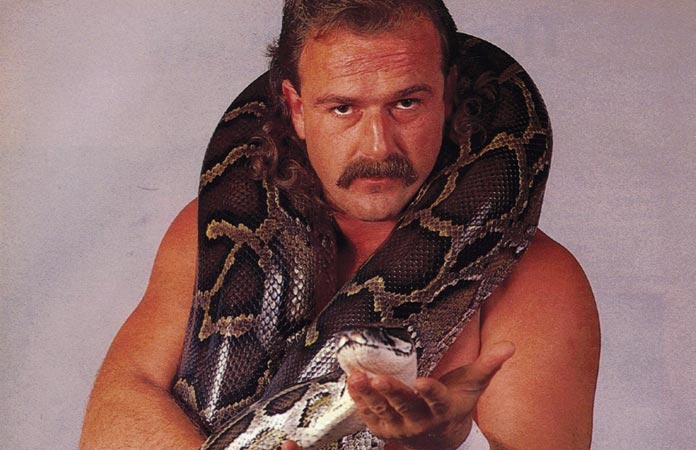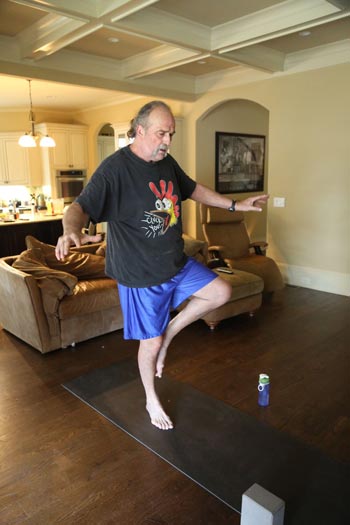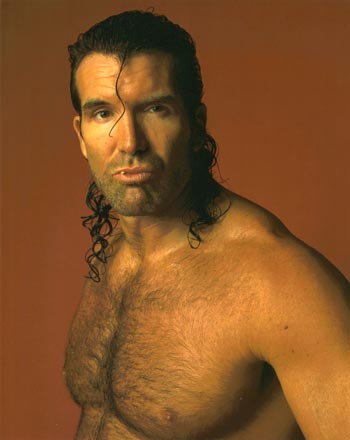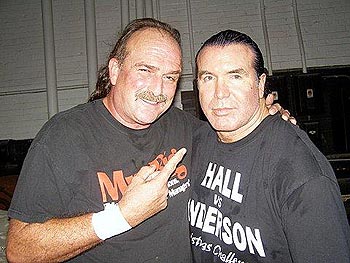The Redemption Of Jake “The Snake” Roberts
Published on February 18th, 2013 in: Pro Wrestling |By Paul Casey

Jake “The Snake” Roberts, for those who do not know, was one of the greatest bad guys in wrestling. One of the most gifted talkers in the business, Jake made you believe more than most. As with other legendary heels like Ric Flair, to work with Jake meant nearly instant credibility for a good guy. He not only inspired genuine hatred, but also fear, especially from younger members of the audience. Inside the ring, Roberts was a creep, a sneak, and a cheat. Outside of the ring he wasn’t too different.
Over his shoulder, he would carry a large black bag containing his pet Damien. A gen-u-ine Python who would come into play during or after a match. Roberts also had one of the best finishers around: The DDT, as elegant a move as has ever been used in professional wrestling. Starting from a front face lock, Jake would throw his body back, planting his opponent face first into the mat. While today the move has become as common as the suplex, Jake did it with great ceremony. The opponent would not flip over as they do now. They would go straight into the mat, or concrete, if Jake was feeling particularly serpentine.
A great finishing move must be able to be performed on anyone, big or small. It should have a sense of unpredictability, with its use coming from any transition. The DDT is the perfect finisher. Raven performs the move in a very similar way and is heavily influenced by Jake, right down to eyeing up his opponent while sitting in the corner.
Jake Roberts had amazing matches with people like Ricky “The Dragon” Steamboat, Macho Man Randy Savage, and The Undertaker. Steamboat was a perfect clean-shaven foil for Roberts’s sleazy and dangerous character. There was no one more athletic than Steamboat in the 1980s, and he set a standard which people like Bret Hart and Shawn Michaels would follow a decade later. The Dragon, like Jake, lived his gimmick. It was easy to imagine Jake breaking a bottle over someone’s head in a bar fight. It was also easy to believe that Steamboat loved his family and avoided the temptations of the road. Steamboat is, in many ways, Roberts’s opposite. In 2009, his efforts to keep his body in shape were apparent to all, when he had a surprising, quality match with Chris Jericho.
Macho Man Randy Savage was successful as a heel or babyface. Savage’s obsessive quest for perfection in the ring and his paranoid attitude with anything to do with his wife Elizabeth needed only to be emphasized to make his character unappealing. As a good guy, though, Savage could also play the foil for Jake perfectly. Savage was the classic showman, the kind of guy who would draw all kinds of heat from just walking into a room, wearing those ridiculous colors. Jake was the guy in the shadows of the bar, waiting to clock that arrogant bastard with a pint glass when his back was turned. Probably their most famous encounter was when Jake coerced his snake to bite Savage. Roberts is at his best here, making it seem like he is genuinely provoking Savage. He is the kind of guy who would rather torture you than kill you.
As Mick Foley writes in his first autobiography, the seminal Have a Nice Day!, The Undertaker had a hard time getting legitimate opponents. Most of the time they fell into the stunt category. People like Giant Gonzales, who were big on looks and size but very short on in ring ability. This meant that Undertaker, a very talented worker, would have to carry the match and rely on spectacle rather than anything approaching a technical display. When Foley was brought into the WWF in the mid-’90s, he was essentially trying to replicate the success of Jake Roberts. Instead of finding a freakishly large man with some kind of growth hormone problem, they would pair Undertaker with someone who could compete with him psychologically. No one was more intimidating than The Undertaker when he debuted at the 1990 Survivor Series. Jake made the fans believe that he was fallible. Their match at WrestleMania VIII was a classic.
After his prime, Jake made a few brief appearances, the last significant one being when he helped propel Stone Cold Steve Austin to mega-stardom at the 1996 King of the Ring. When he beat Jake, who was working a religious gimmick, Austin cut the most important promo of his career. “Austin 3:16” was the driving force which would push Stone Cold to become the biggest star in the world.
Outside of the ring, things were more difficult for Roberts. When his popularity waned, there was little else to occupy his life. Like so many people struggling with substance abuse and emotional scars, the wrestling business was not a good place to be. Reliability is one of the most important things in professional wrestling. Turning up to the arena on time to ensure that you and your partner are prepared for your match is vital. Being confident that the other guy is in a fit state to wrestle is obviously an aesthetic consideration. No one wants to have a shitter of a match. More important, though, is knowing that the other person will be there when you need them. Stepping into the ring while drunk or high is one of the most dangerous things a performer can do. Bad timing can lead to paralysis or death.

Jake Roberts
Anyone who has seen the excellent Beyond The Mat will know how disturbing a life Roberts has endured: Severe problems with drugs and alcohol, a tragic and bizarre family life, and an immense talent for the business that could never quite compensate. While many names were thrown around at the time, there is no other person who reflects Mickey Rourke’s character in The Wrestler as closely as Jake “The Snake” Roberts.
Recently, however, it has become apparent that Roberts is making a large effort to better himself. While it is easy to be cynical, it is hard not to believe after reading Mike Mooneyham’s excellent profile that this is the best chance he has had in at least two decades to finally step away from a life of self-destruction. As the article points out, Diamond Dallas Page was trained by Roberts early on in his career. Page is famous as a backstage motivator and a believer that hard work can solve any problem. Those familiar with his struggle to make the transition from personality to in-ring talent—respected by people like Booker T and Sting—will know how important this positive attitude was to his success.
As I covered in my last wrestling article, the wrestling business can be callous and uncaring. To see Page help his old friend in such a way gives one hope that even the most down and out person can recover. These problems are of course deeper than issues with diet and weight. If Jake Roberts can continue to improve his life though, he will not only give the wrestling world a considerable gift, he will give hope to all people who have given up the fight. There is no one who needs hope more now than Scott Hall.
If there is anyone who is as well known for squandered talent as Jake Roberts, it is that eternal outsider. Scott Hall was a major reason why wrestling was so successful in the 1990s. He had some great matches, including a very influential ladder match with Shawn Michaels. While guys like Bret Hart claim, correctly but foolishly, that he was having ladder matches long before anyone had ever heard of Shawn Michaels, it is clear that the template for how ladder matches worked in the modern context was established at WrestleMania X.

Scott Hall
Hall not only mixed a great look and quality in ring work with a mess of charisma, but also a fourth-wall-breaking attitude that managed to acknowledge the scripted nature of wrestling in such a way that made it feel real. This is quite a trick. There are many critics of this approach. People like Fit Finley, Ric Flair, and manager/promoter Jim Cornette claim that Hall, his best friend Kevin Nash, and the NWO stable “exposed” the business in a negative way.
This is a bad argument, at least for how Scott Hall operated within the “worked shoot” nature of his character in WCW. Hall and Nash functioned well as the bad guys. Mainstream wrestling was using its actual nature to create storylines and matches that, for the first time in a long time, were ahead of the fans’ expectations. If anything, they confused the issue in such a way that fans were no longer sure exactly where the reality was in among all of the fantasy. For any entertainer dealing in illusion, surely this is a positive.
After Hall left the WWF—where he wrestled under the name Razor Ramon—he turned up on WCW’s main show, Nitro. Employing huge stars like Hulk Hogan and Macho Man was a necessary component of Eric Bischoff’s success, but it was not sufficient. WCW became the best thing going when Scott Hall stepped into that ring and delivered perhaps the most important promo of the 1990s. After that night, professional wrestling would become self aware in a way it had never been before.
A lot of the bad feeling Hall and Nash still receive for this period is to do with their reputation for seriously bad behavior, as well as for having the kind of contractual guarantees that meant they would be paid as much as any talent in the locker room, present or future. Cases of Sol, painkillers, and other substances made for terrible encounters in hotel lobbies and long, long bus rides. Unlike Kevin Nash, Scott Hall never grew out of it. Hall’s behavior and dependencies on pills and alcohol just got worse as time went on. Like Jake Roberts, when the business stopped facilitating his behavior, the fall was sharp and hard.
In a 2002 documentary on the NWO—after he had briefly returned to the WWF—Hall mentioned that the lack of Vince McMahon’s watchful eye was a big reason why things got bad. When he had been known as Razor Ramon, Vince McMahon would not tolerate his late appearance to a show. If he started slipping in the ring, whether drunk or high, he would know that he would answer for it. In WCW no one really cared. Hall, Nash, and the other highly paid members of the roster could basically do what they wanted.

Jake Roberts and Scott Hall
As many pitfalls as pro wrestling has for people like Scott Hall and Jake Roberts, they need it. They need the structure and the creative satisfaction from a job well done. That is why is it is inspiring to see Diamond Dallas Page reach out to his friends and help them put that structure back in their lives. A couple of days ago DDP uploaded a video which showed him and Jake calling a very removed Scott Hall, asking him to consider joining them. The video is now gone, presumably out of concern for Scott Hall’s family.
Watching the call was upsetting as a wrestling fan and as a human being. “I’m dying, and I don’t want to die.” A person who was so important to this art form that I love, and who still has so much to offer, is reduced to this lowest point. As mentioned last time, a watch of ESPN’s (kind of sneering) documentary on Scott Hall will leave you shaken. If Jake Roberts can somehow, with the help of DDP, be an example for people like Scott Hall and affect some meaningful change, then he will leave more than a wrestling legacy to be proud of.
Time limit is exhausted. Please reload the CAPTCHA.